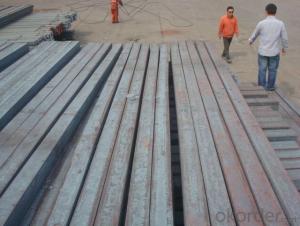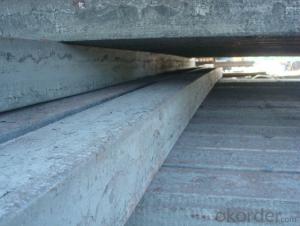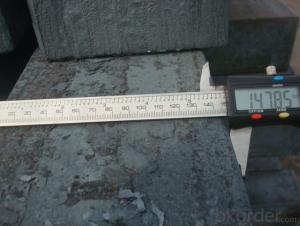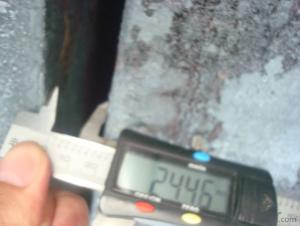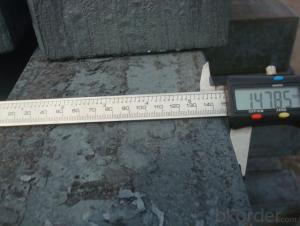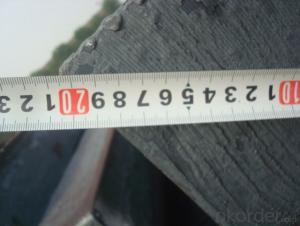Steel Bloom/Billet Manufactured by Blast Furnace
- Loading Port:
- Tianjin
- Payment Terms:
- TT OR LC
- Min Order Qty:
- 1000 m.t.
- Supply Capability:
- 10000 m.t./month
OKorder Service Pledge
OKorder Financial Service
You Might Also Like
Steel Bloom/Billet Manufactured by Blast Furnace
1.Structure of Steel Bloom/Billet Manufactured by Blast Furnace
Steel Billets Manufactured by Continue Casting is the raw material of all kinds of steel mill. Billet section of square, round, flat, rectangular and abnormity, etc Several, mainly related to shape of rolled products. Simple rolled section steel, choose cross section of square billet or rectangular billet. rolling The sector products such as flat steel, Angle steel, select the rectangular billet or slab. Had better profiled billet when production beams, channels, and in rolling process Lines and improve the yield. The raw material of round billet is the production of seamless tube.
2.Main Features of Steel Bloom/Billet Manufactured by Blast Furnace.
Steel Billets Manufactured by Continue Casting section size should meet the requirements of rolling deformation and finished product quality, but also roll strength and biting condition of restrictions. General steel Billet section height H. And the roll diameter D The ratio of the ( namely H/D) Should be less than or equal to zero 0.5 . Length of steel billet by finishing temperature, Rolling time and the length of the product Or times ruler. When heated too long accident prone to bump the furnace wall of steel, too short, furnace bottom utilization rate is not high, influence the heating furnace production. For the production Choose a variety of steel and steel billet, should consider the affinities of billet, as far as possible in order to improve the productivity of the roughing mill, simplify the stock management of workshop.
There are three shapes of the steel billets: square billet, slab, rectangular billet The Chinese billet, rectangular billet is mainly suitable for rolling hot rolled strip, building reinforced bar, Ordinary wire, high speed wire rod and various small profile. Of the slab are mainly used for rolling plate and hot coil sheet.
3. Steel Bloom/Billet Manufactured by Blast Furnace Images
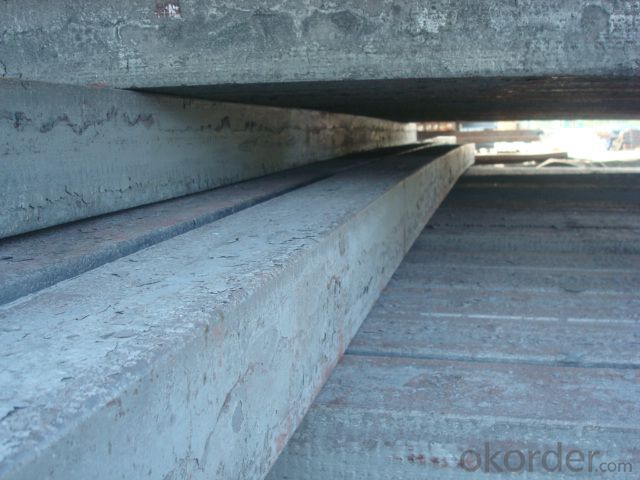
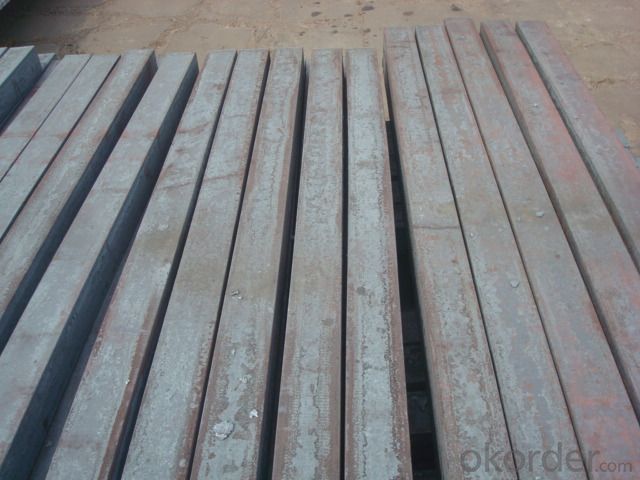
4. Steel Bloom/Billet Manufactured by Blast Furnace Specification
Steel Bloom/Billet Manufactured by Blast Furnace rolled steel, after processing can be used for mechanical parts, forging parts, processing all kinds of steel, steel Q345B channel steel, wire rod is the role of the billet. Steel billet is used in the production of semi-finished products, generally cannot be used directly for the society. Steel billets and steel are strictly divided into standard, cannot decide to whether the business enterprise of the final product, and according to unified standards to perform the whole society. Typically, billet and the steel is relatively easy to distinguish, but for some steel billet, and have the same specification and same steel purposes (such as rolling tube billet), whether can be used for other industries, whether through steel processing process, whether through a finished product rolling mill processing to distinguish
Material standard The editor Range of thickness: 150-240 - mm + / - 5 mm width range: 880-1530 - mm + / - 20 mm Length: 3700-10000 - mm + / - 500 - mm Cross-sectional size: 64 * 64; 82 * 82; 98 * 98; 124 * 124; 120 * 150; 152 * 164; 152 * 170 mm Length: 9000 mm Section of tolerance: billet: 1.0 + / - 2.0-1.0 + / - 1.0 mm slab: width: + / - 2.0 mm thickness: + / - 3.0 mm The length tolerance: + / - 200 mm Section diagonal tolerance: 3.5-8.0 MM Billet section size protrusions requirements: < 1242 mm, do not allow; > = 1242 mm, < = 2 mm 1242 mm, < = 3 mm Beheading (shear) extension deformation: < 1242 mm billet: no control; The slab: < = 15 mm Surface tilt: no more than billet section 0.1 Bending: every 1 m length is not more than 10 mm The distortion: length < = 5 m, < = 11. ; The length of the < = 7.5 M, < = 5. Material % 3 sp/PS chemical composition: C Mn Si S P
5.FAQ of Steel Bloom/Billet Manufactured by Blast Furnace
We have organized several common questions for our clients,may help you sincerely:
①How about your company?
A world class manufacturer & supplier of castings forging in carbon steel and alloy steel,is one of the large-scale professional investment casting production bases in China,consisting of both casting foundry forging and machining factory. Annually more than 8000 tons Precision casting and forging parts are exported to markets in Europe,America and Japan. OEM casting and forging service available according to customer’s requirements.
②How to guarantee the quality of the products?
We have established the international advanced quality management system,every link from raw material to final product we have strict quality test;We resolutely put an end to unqualified products flowing into the market. At the same time, we will provide necessary follow-up service assurance.
③What is the advantage of the continue Casting steel billet comparing to the die casting steel billet?
Compared with die casting, continuous casting has the advantages of: 1. To simplify the Steel billet The production process 2. Improve the metal yield 3. Improve the quality of the billet 4. Reduces the steel worker's labor intensity 5. Save energy and reduce consumption
Steel billet is produced by the method of through three processes: It is through the steelmaking system of continuous casting equipment, directly by the molten steel pouring into billet; The second is the steelmaking system in the production of steel ingot casting billet through system of steel rolling rolling equipment or processing of steel semi-finished products; Three is the steelmaking system production of steel ingot by forging the semi-finished product processing equipment.
- Q: What are the different heat treatment processes for alloy steel billets?
- Alloy steel billets can undergo various heat treatment processes depending on the desired properties and intended application. Some commonly used processes include: 1. Annealing: The billets are heated to a specific temperature and slowly cooled, typically in a furnace. This relieves internal stresses and improves machinability. 2. Normalizing: Similar to annealing, but the cooling is done in still air. It refines the grain structure and enhances mechanical properties like strength and hardness. 3. Quenching and tempering: The heated alloy steel is rapidly cooled in a liquid medium, such as oil or water, to achieve high hardness and strength. Subsequently, the billets are reheated to a lower temperature to reduce brittleness and improve toughness. 4. Precipitation hardening: This process is suitable for alloy steels containing elements like aluminum, copper, or titanium. It involves a series of heat treatments that cause fine particles to form within the steel, resulting in improved strength and hardness. 5. Case hardening: Used to increase the hardness of the outer layer of the billets, this surface heat treatment process involves heating in the presence of a carbon-rich atmosphere or applying a carbon-rich compound. It is followed by quenching and tempering. These are just a few examples of the many heat treatment processes available for alloy steel billets. The choice depends on factors such as alloy composition, desired properties, and intended application. It is essential to carefully consider these factors and seek advice from heat treatment experts to achieve the desired outcome.
- Q: How are steel billets used in the manufacturing of springs?
- Steel billets are used in the manufacturing of springs by being heated and then forged or rolled into the desired shape and size. These billets serve as the raw material for producing high-quality springs, providing the necessary strength and durability required for various applications.
- Q: How are steel billets used in the production of agricultural harvesting equipment?
- Steel billets are a crucial component in the production of agricultural harvesting equipment due to their strength, durability, and versatility. These billets are typically used to create the main structural framework of various types of agricultural machinery, such as combine harvesters, threshers, and balers. One of the primary applications of steel billets in the production of agricultural harvesting equipment is in the construction of the machine's frame. The frame serves as the backbone of the equipment, providing stability and support for all other components. Steel billets are ideal for this purpose as they have high tensile strength, allowing them to withstand the heavy loads and stresses encountered during harvesting operations. Additionally, steel billets are also utilized to manufacture various critical components of agricultural machinery. For example, they are often used to produce cutting blades, augers, and conveyors, which are essential for efficiently harvesting and processing crops. Steel's excellent wear resistance and toughness make it an ideal material for these components, as they need to withstand the abrasion and impact caused by contact with crops and other debris. Furthermore, steel billets are commonly employed in the manufacturing of hoppers, chutes, and other storage and transportation systems within agricultural harvesting equipment. These components are responsible for collecting, sorting, and transferring harvested crops, and therefore need to be robust and reliable. Steel billets provide the necessary strength and rigidity to ensure the efficient handling and movement of agricultural products. In summary, steel billets play a vital role in the production of agricultural harvesting equipment. Their strength, durability, and versatility make them indispensable for creating the main structural framework, critical components, and storage systems of these machines. By utilizing steel billets, manufacturers can ensure the production of reliable and efficient agricultural machinery that can withstand the demanding conditions of harvesting operations.
- Q: What are the main challenges in the storage of steel billets?
- The main challenges in the storage of steel billets include maintaining proper environmental conditions, managing space efficiently, ensuring safety measures, preventing corrosion, and minimizing material damage. Firstly, the storage area should be maintained at a controlled temperature and humidity to prevent the steel billets from being exposed to extreme weather conditions, which could lead to rusting, oxidation, or other forms of corrosion. Adequate ventilation is also necessary to prevent the buildup of moisture that could affect the quality of the billets. Secondly, managing space efficiently is crucial in steel billet storage. Billets are often stored in large quantities, so proper organization and stacking methods must be employed to maximize the storage capacity and facilitate easy access to individual billets when needed. Implementing effective inventory management systems can help prevent unnecessary handling and potential damage. Safety measures are another significant challenge in steel billet storage. Due to their heavy weight and potential for sharp edges, it is essential to ensure proper handling and storage procedures to avoid accidents or injuries. Adequate training for personnel and the use of appropriate lifting equipment are necessary to maintain a safe working environment. Corrosion prevention is a critical concern in steel billet storage. Applying protective coatings, such as oil or rust inhibitors, can help shield the billets from moisture and prevent oxidation. Regular inspections and maintenance routines are also necessary to identify and address any signs of corrosion promptly. Lastly, minimizing material damage is crucial in steel billet storage. Proper handling techniques, such as avoiding dropping or dragging the billets, should be followed to prevent deformation or surface damage. Using suitable packaging or padding materials during transportation and storage can also help protect the billets from scratches or other physical impacts. In conclusion, the main challenges in the storage of steel billets revolve around maintaining proper environmental conditions, efficient space management, ensuring safety measures, preventing corrosion, and minimizing material damage. By addressing these challenges effectively, the longevity and quality of the steel billets can be preserved, resulting in enhanced operational efficiency and customer satisfaction.
- Q: Can steel billets be used in the production of consumer electronics?
- Typically, steel billets aren't utilized in the production of consumer electronics. These semi-finished steel products are commonly employed as raw materials in manufacturing other steel products like bars, rods, and pipes. Conversely, consumer electronics are typically manufactured using diverse materials like plastics, metals such as aluminum and copper, and electronic components like circuit boards and semiconductors. Although steel may be utilized in certain components of consumer electronics, like the casing or frame, it is typically in a more refined form such as sheet metal or extruded profiles, rather than steel billets.
- Q: What are the potential applications of steel billets in the mining industry?
- Steel billets have a wide range of potential applications in the mining industry. Firstly, steel billets can be used in the construction of mining equipment and machinery. These billets can be shaped and welded to form various components such as frames, supports, and chassis for heavy mining machinery. The strength and durability of steel make it an ideal material for withstanding the harsh conditions and heavy loads encountered in mining operations. Secondly, steel billets can be utilized in the fabrication of conveyor belts, which are essential for the transportation of bulk materials in mines. The high tensile strength of steel ensures that the conveyor belts can withstand the weight of the material being transported, as well as the continuous movement and impact from the mining process. Additionally, steel billets can be employed in the construction of underground support systems, such as mine shafts and tunnels. These structures require strong and reliable materials to ensure the safety of workers and the integrity of the mining operation. Steel billets can be used to manufacture support beams, rods, and plates, providing the necessary stability and reinforcement. Moreover, steel billets can be used in the production of wear-resistant components, such as grinding balls and liners, which are crucial in mineral processing. These components are used in grinding mills to crush and grind the ore, and the abrasion-resistant properties of steel make it a suitable material for this application. By using steel billets, mining companies can enhance the efficiency and longevity of their mineral processing operations. Overall, the potential applications of steel billets in the mining industry are extensive. From equipment manufacturing and conveyor belt fabrication to underground support systems and wear-resistant components, steel billets play a vital role in improving the productivity, safety, and efficiency of mining operations.
- Q: How are steel billets used in the production of turbine blades?
- Turbine blades rely heavily on steel billets, which serve as a fundamental building block in their production. These billets, essentially semi-finished steel products, serve as the initial material for the manufacturing process. To commence, the selection of steel billets is a meticulous process, taking into account specific requirements such as composition, strength, and durability. Once chosen, the billets undergo a series of processing steps to transform them into turbine blades. The initial step involves subjecting the steel billets to high temperatures in a furnace, a process known as forging. This procedure enhances the malleability of the steel, making it easier to work with. Once heated, the billets are then shaped into turbine blades through the application of mechanical forces. Following the initial forging process, the turbine blades are refined through a range of machining operations. These operations encompass precision cutting, grinding, and drilling, all aimed at achieving the desired dimensions, surface finish, and aerodynamic profiles. Aside from shaping and refinement, steel billets also play a pivotal role in strengthening and ensuring the integrity of turbine blades. Through heat treatment processes like quenching and tempering, the billets are hardened and tempered, resulting in desired mechanical properties such as high strength and resistance to fatigue. Moreover, steel billets provide the necessary material properties to withstand the harsh operating conditions of turbines. They exhibit excellent corrosion resistance, a crucial attribute for blades operating in environments with high temperatures, pressure, and moisture. In summary, steel billets are indispensable in turbine blade production as they serve as the starting material, facilitate shaping and refinement, and offer the required strength and durability for these critical components in power generation.
- Q: What is the billet price in China today?
- Building materials tend to be stable, the price is good to pick up the trend, the overall no big changes, specific to my steel network detailed inquiries, information here will be updated every day
- Q: What are the main factors affecting the impact toughness of steel billets?
- The impact toughness of steel billets can be affected by several main factors. Firstly, the toughness of the steel is significantly influenced by its chemical composition. Alloying elements like carbon, manganese, and nickel can enhance toughness. Higher carbon content increases hardness but decreases impact toughness. On the other hand, the addition of manganese and nickel promotes the formation of fine-grained structures, improving toughness. Secondly, the heat treatment process used during steel billet production plays a crucial role in their toughness. Annealing and quenching processes refine the microstructure of the steel, making it more resistant to cracking and brittle fracture. However, improper heat treatment or rapid cooling rates can lead to the formation of undesirable phases or microstructural defects, reducing impact toughness. Thirdly, the presence of impurities and inclusions in the steel also affects its toughness. Non-metallic inclusions, such as sulfides and oxides, act as stress concentrators and initiate crack propagation during impact loading. Therefore, steel with lower impurity levels and cleaner inclusion content exhibits higher toughness. Moreover, the grain size of the steel significantly influences its toughness. Finer grain sizes improve toughness due to the increased number of grain boundaries that act as barriers to crack propagation. Thus, steel billets with smaller grain sizes are more resistant to brittle fracture. Lastly, the mechanical working processes like hot rolling or forging can affect the toughness of steel billets. These processes induce deformation and strain hardening, increasing strength but potentially decreasing toughness. Careful control of deformation parameters is necessary to balance strength and toughness in steel billets. To summarize, the impact toughness of steel billets is influenced by various factors, including chemical composition, heat treatment, impurities and inclusions, grain size, and mechanical working processes. Understanding and optimizing these factors are crucial in producing steel billets with the desired toughness for specific applications.
- Q: What is the typical fatigue strength of a steel billet?
- The typical fatigue strength of a steel billet can vary depending on several factors such as the specific composition of the steel, the manufacturing process, and any surface treatments applied. Generally, fatigue strength refers to the ability of a material to withstand repeated loading and unloading cycles without failure. Steel, being a strong and durable material, typically exhibits a high fatigue strength compared to other materials. However, the exact value of fatigue strength can vary significantly depending on the specific grade of steel and its intended application. In engineering and industry, fatigue strength is often represented by a stress-life (S-N) curve, which plots the stress level applied to the steel billet against the number of cycles to failure. The shape of the curve provides valuable information about the fatigue behavior of the steel. It is important to note that the fatigue strength of a steel billet is usually determined through rigorous testing procedures, such as fatigue testing machines that subject the material to cyclic loading until failure occurs. These tests help engineers and manufacturers establish the safe operating limits for different steel grades and applications. Therefore, without specific information about the steel grade, manufacturing process, and any additional factors, it is not possible to provide a precise value for the typical fatigue strength of a steel billet. However, it is generally understood that steel has good fatigue resistance and can withstand a significant number of cycles before failure, making it a reliable choice for many structural and mechanical applications.
Send your message to us
Steel Bloom/Billet Manufactured by Blast Furnace
- Loading Port:
- Tianjin
- Payment Terms:
- TT OR LC
- Min Order Qty:
- 1000 m.t.
- Supply Capability:
- 10000 m.t./month
OKorder Service Pledge
OKorder Financial Service
Similar products
Hot products
Hot Searches
Related keywords







